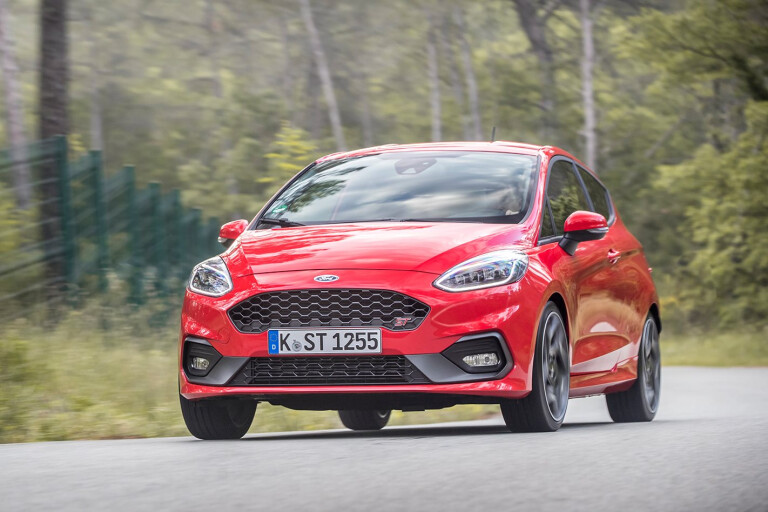
Ford’s ability to craft hot hatches that are brilliant to drive is without question. However, their day-to-day usability, comfort and quality has been less well-defined. The outgoing Fiesta ST was a prime example; fast as hell, but far from comfy.
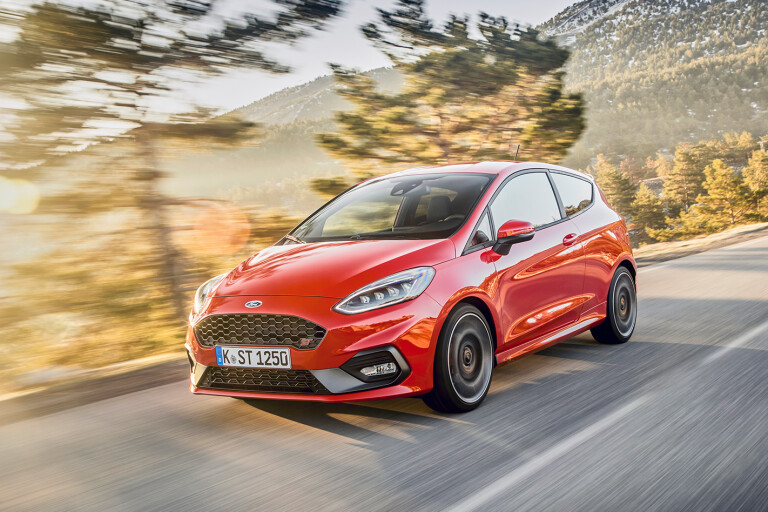
Now on sale in Europe, the new third-gen Fiesta ST promises to do things differently, without compromising on performance.
WHAT IS IT?
The third generation of the Fiesta’s performance flagship grade, the ST. Though its platform is an extensive evolution of the old car’s underpinnings – rather than an all-new architecture – the changes are wholesale. New engine (with one less cylinder than before), innovative suspension technology, impressive traction aids and a thoroughly modern interior all mark it well apart from the car it replaces.
WHY WE’RE TESTING IT
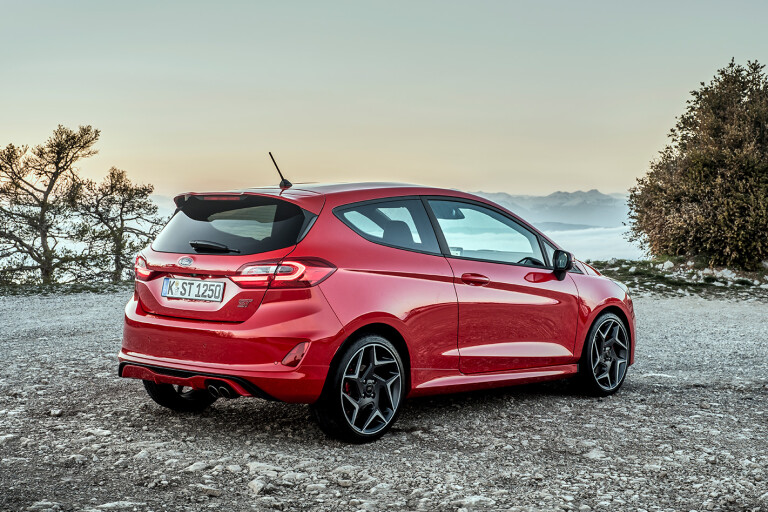
There’s one big question that’s on everyone’s lips: can a three-cylinder hatchback boast genuine performance appeal? The downsizing trend has been in full swing for a while now, but the Fiesta ST is the first hot hatch in its size category to drop a cylinder in favour of three-pot power. That alone is reason to investigate, but we also want to examine whether the new Fiesta ST remains as sharp to drive as the old one, and whether Ford has addressed complaints about cabin quality and ergonomics – key criticisms of the outgoing ST.
MAIN RIVALS
Volkswagen Polo GTI, Suzuki Swift Sport, Renault Clio RS, Peugeot 208 GTi
THE WHEELS VERDICT
Ignore the three-cylinder part, because the term “downsizing” has negative connotations that simply don’t apply to the Fiesta ST. Instead, Ford Performance has truly managed to create more with less. Through intelligent engineering and clever design, the new ST isn’t just better than its predecessor – it’s better than the vast majority of its rivals in more than one regard.
PLUS: Awesome grip from LSD and sticky tyres; cabin quality; torquey engine; neutral chassis; enjoyable engine note
MINUS: Not here until early 2019; no automatic option for those that want it; pedal spacing
THE WHEELS REVIEW
IT’S A CHEEKY move by Ford to stage the launch of its third-generation Fiesta ST in France, given La Republique is home ground for scorching B-segmenters like the Clio RS and Pug 208 GTi.

Yet here we are, on one of the twistier portions of the Route Napoleon, sitting inside the Blue Oval’s newest and most affordable performance car. The Fiesta is well and truly behind enemy lines right now, but it’s clutching a garrotte in one hand.
Ford’s European arm knows a thing or two about making compact hatches go fast. This 2018 model might be the third generation of car to wear the Fiesta ST moniker, but the lineage stretches all the way back to the 1981 Fiesta XR2. Those decades of experience are manifest in the way the latest Fiesta ST drives.
“What we wanted to achieve was improve in four areas.”
That’s Leo Roeks, director of Ford Performance’s European operation.
“One was the powertrain, the engine. Power obviously, but also CO2 emissions. Then there was the seating position.

“Another thing that’s very important is obviously ride, handling and steering, and the other thing is noise. Does a three-cylinder actually work for a sports car? I can guarantee you that yes it does.”
Proving naysayers wrong will be the Fiesta ST’s greatest challenge. Ford Performance’s decision to deploy a three-cylinder Ecoboost with just 1.5 litres of swept volume will no doubt have spec sheet fiends scratching their heads (especially given the new ST weighs more than the old car, and rival Polo GTI now boasts a big-block 2.0L), but Roeks and his team have equipped the humble Fiesta with an arsenal of go-faster tricks to boost its athletic ability, despite its smaller heart.
The ST suffix stands for ‘Sport Technology’, and there’s plenty of both in the fastest Fiesta. Technology helps counteract the reductions in displacement and cylinder count, with the new triple’s 147kW of peak power and 290Nm of maximum torque exceeding the official stats of the outgoing 1.6 by 13kW and 50Nm respectively. Incidentally, those numbers are also identical to what the second-gen ST generated when operating in overboost, which could only be done for 20 seconds at a time.
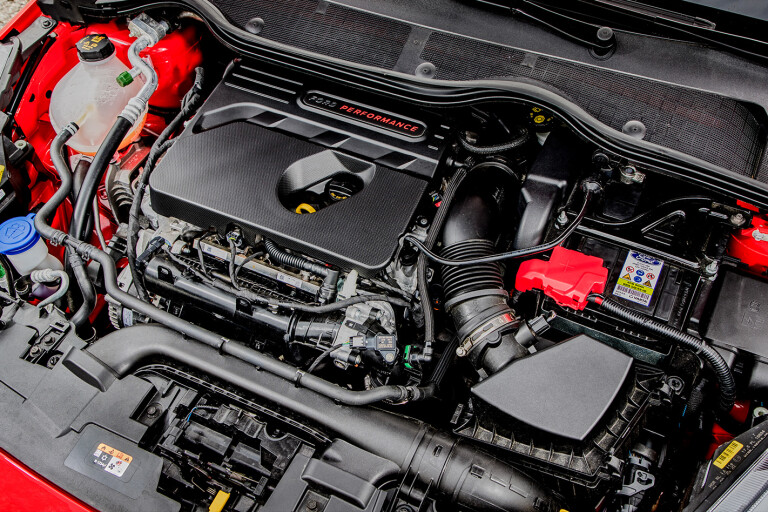
High-pressure direct fuel injection (working in concert with port injection), variable intake and exhaust cam timing, and clever turbine geometry are responsible for the 1.5’s prodigious muscle, and also help mitigate turbo lag. The result of all this is a 0.4 second faster 0-100km/h sprint compared to the outgoing Fiesta ST, trimming the stat down to a neat 6.5 seconds despite the new car’s 90kg of extra mass.
Amazingly, it also has cylinder deactivation. By decoupling the rocker arms for cylinder number one, the Fiesta ST’s three-pot can morph into a two-pot to help curb its thirst on light-throttle cruising. On the combined cycle, Ford claims the ST sips 6.0L/100km on average.
The tech story continues beneath. The rear suspension may be a mechanically simple torsion beam, but it’s augmented by what Ford Performance calls “force vectoring” springs that are banana-shaped in profile, wound in opposite directions and work to increase the rear axle’s lateral stiffness without requiring a Watts linkage – thus netting a weight saving of 10kg.
Then there are frequency-dependent shock absorbers at each corner – twin tubes at the front, mono-tubes at the back – that adjust damping force depending on the severity of the road surface.
The front knuckles have ST-specific geometry, and no matter whether you spec the standard 17-inch alloys or their more attractive 18-inch counterparts, the new ST rolls on grippy Michelin Pilot Super Sports – rubber that’s more commonly found on things like BMW M3s, not sub-$30K hatches. In fact, the Renault Clio RS220 Trophy is the only other competitor we can think of that rolls on Super Sports, and it retails for nearly $40K. The Fiesta ST should be well over ten grand cheaper, but more on that later.
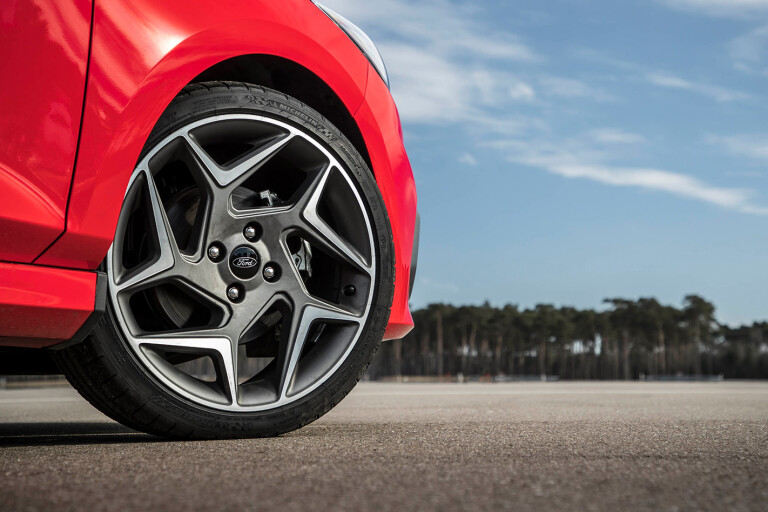
Launch control is a new feature for the ST as well, but the most transformational improvement is the addition of a Quaife limited-slip differential to the six-speed transaxle. It’s a proper mechanical unit rather than the brake-based virtual LSDs used by practically every other B-segment hot hatch, and while it’s optional in Europe, Wheels understands it’s likely to be standard-issue in Australia.
Helping it out is brake torque vectoring, which varies braking force between the left and right wheels to aid turn-in when decelerating or coasting, as well as mitigating understeer.
So that’s what makes the new ST tick. Let’s return to the Route Napoleon - it’s Ascension Day, a public holiday in France, and everyone with a fast car or motorcycle seems to have gravitated toward this road. Little wonder, considering the exceptional mix of fast sweepers and tight corners that can be found on the route around the town of Castellane. It’s prime hot hatch territory. We’re in a three-door ST equipped with the LSD and 18s – the lightest, most focused configuration – and it feels eager to attack what lies ahead.
The rubbery shifter isn’t especially precise, but the vague friction point that plagued the old car’s clutch pedal has been banished for good. Tipping in the throttle, the first impression is that the engine its far gutsier than expected of a 1.5-litre, and the swell of torque from just off idle endows it with outstanding tractability.
In Sport mode with the muffler flaps flipped open the three-cylinder burble also adds another endearing facet to this engine’s personality, though it’s unlike any other three-pot we’ve experienced. Rather, it sounds smoother and more V6-like (or even flat-six-like) than, say, the Audi A3’s 1.0-litre triple. Sport and Race modes also summon some extra theatrics from the fuel map, with rally-style exhaust crackles on big lifts of the throttle.
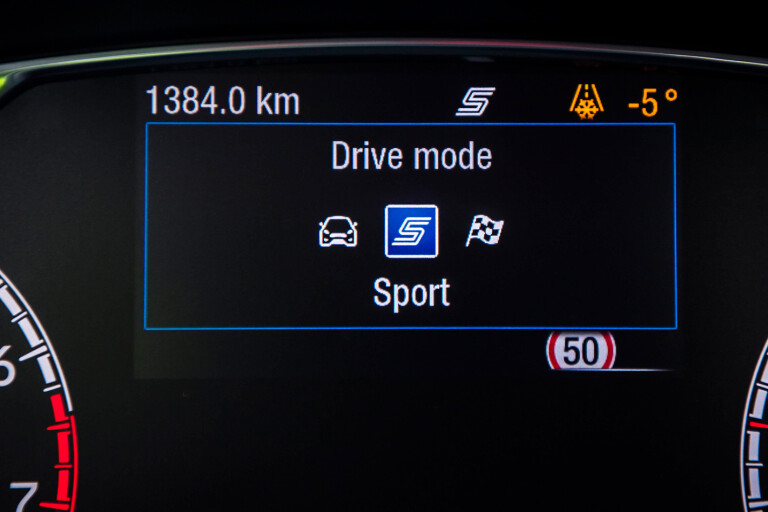
And the more revs you give it, the better it becomes. It’s torque-rich, yes, but it doesn’t mind chasing redline either. Keep the needle above 3000rpm and there’s no shortage of pull or throttle response until 6000rpm, where peak power is made and thrust starts to taper off before the ST’s 6200rpm redline.
That straight-line go is matched with a properly tied-down front end. There’s huge grip on these Michelins, and the limited-slip differential is a godsend. It lays power down beautifully, with no pauses in power delivery as chassis electronics attempt to rein in spinning wheels – just pure mechanical grip. The Quaife diff isn’t locked in for Australia, but the impact it makes on performance is so profound that it damn well ought to be. We had a punt in an open-diffed five-door and, while fast, it was missing the almost effortless traction of the LSD-equipped three-door and was slower as a result.
Both cars feel exceptionally alert through the steering wheel though, with a fat, leather-wrapped rim connected to an ultra-sharp and fast-ratio steering rack. As with its predecessor there’s virtually zero slack in its steering, though now (thanks to new geometry, those force-vectoring rear springs, frequency-selective dampers and improved suspension bushings) there’s a level of pliancy and fluidity to the Fiesta ST’s ride and handling that helps it cope with choppier roads. In other words, it’s actually comfortable now.
And that marks it apart from the Frenchies. With a chassis that’s more contained and sporty than the 208 GTi, yet not as single-mindedly firm as the Clio RS, the Fiesta ST eats up French roads with ease, peerless traction and few, if any, compromises. Does it beat them at their own game, on their own turf? Shockingly, it would seem so, and it’s going to be a blinder of a comparison test in Oz to find out for sure.
The ST’s limpet grip on the tarmac is hard to breach, but with enough inertia, the slacker ESP of the ‘Race’ drive mode, and a sharp lift n’ flick of the throttle and steering, the Fiesta ST’s rear end goes light and rotates around. It’s not the flamboyant kind of pirouette that you’d get in something like a Clio RS (especially non-Trophy models and their less sticky tyres), but at the same time it feels far more approachable, progressive and predictable when driven at the limit. Quite like its big bro, the Focus ST.
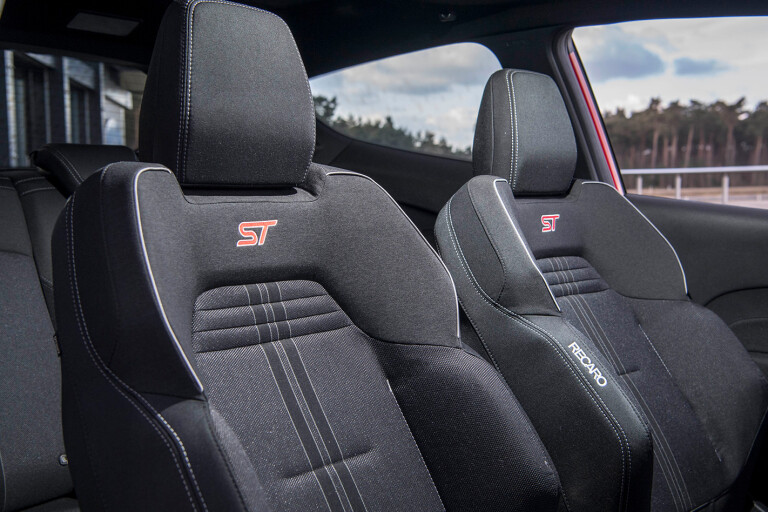
It’s hard to discern a dynamic distinction between the three-door and five-door, in case you were wondering. With just 21 kilograms separating them and identical length, track width and wheelbase, the two bodystyles handle virtually identically.
Problems? Very few. The pedals are still a little awkwardly spaced for neat heel-toe downshifts, and there’s no downshift rev-matching tech – or automatic option – to compensate for that. Automatic transmissions may be Kryptonite for many keen drivers, but self-shifting ‘boxes are fast becoming critical for commercial success. Even so, Ford has no immediate plans for an auto Fiesta ST. One could potentially join the family in the future, but for the time being all Fiesta STs will come with three pedals – no fewer.
The shift gate itself could also be tighter, and the lid for the centre console box gets in the way of elbows when selecting second, fourth or sixth. There’s a smidge of torque steer too, but it’s easily contained if you have both hands on the wheel, and there are few genuine qualms otherwise.
As with the outgoing car there’s a pair of Recaros up front, but this time they’re mounted on rails with plenty of height adjustment, while the steering column has a greater range of movement in both reach and rake. The old car suffered from bad ergonomics and perched the driver in a very un-sporty and upright seating position, but getting comfy behind the wheel of a Fiesta ST is no longer a challenge.
And while the second-gen ST was let down by a dated interior that boasted Nokia aesthetics in the iPhone era, its replacement suffers no such ailment. The new ST’s box-fresh interior lifts cabin quality significantly while also flaunting Ford’s latest and greatest SYNC3 infotainment system on an 8-inch tombstone-style screen (6.5in on low-spec Euro models), surrounded by cabin plastics that no longer have a Fisher-Price vibe.
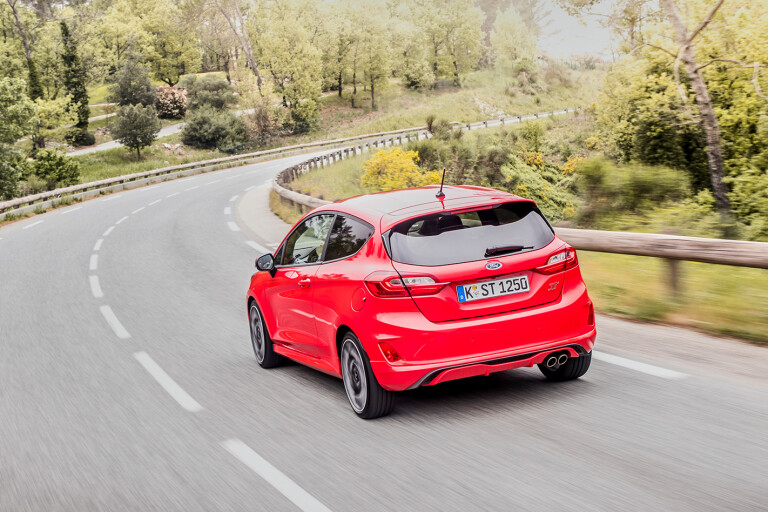
The worst part is that we’ll have to wait so long for it. While it will have already launched in Europe by the time you read this, the Fiesta ST isn’t coming to our shores until the end of Q1, 2019. The final specifications of our cars have yet to be locked down, too.
As for bodystyle, it’ll be a hard decision for Ford Australia to make; to bring in the more overtly sporty, better-looking and somewhat selfish three-door, or capitulate to the demands of the public and give them the one with better everyday utility – the five-door. With the Fiesta ST being the sole Fiesta to go on sale in Australia, it’s unlikely we’ll receive both. Profit margins must be maintained, after all, and amortising the extra cost of bringing in two bodystyles will be a challenge for a car that won’t sell in volume.
And while the excellent Quaife differential should be a sure-fire inclusion for Australia, it’s less clear whether we’ll get the 17-inch alloys or the more eye-pleasing (and slightly sharper handling) 18-inch items instead. Local pricing is still to be determined, but a realistic window lies between $27-30K. With the new Polo GTI lobbing at $30,990 with an auto transmission as standard, the fast Fiesta will have to be priced well under that mark.
But whatever the price, be thankful that we’re getting it at all. Next year, the Fiesta ST will be the only Fiesta you’ll be able to buy brand-new from an Australian Ford dealer. Why? Because with production of the new-gen car now centralised in Europe, there’s no longer a fat enough profit margin in lower-grade Fiestas to enable a solid business case on our shores. However with a $25K-plus pricetag, the Fiesta ST has enough meat to make it worthwhile for Ford Australia and the dealerships that will sell them.

The wait will be a long one, but for those that can hold out it’ll most definitely be worth it.
SPECS
Model: Ford Fiesta ST three-door
Engine: 1497cc 3cyl, dohc, 12v, turbo
Max power: 147kW @ 6000rpm
Max torque: 290Nm @ 1600-4000rpm
Transmission: 6-speed manual
L/W/H: 4068/1735/1469mm
Wheelbase: 2493mm
Weight: 1262kg
0-100km/h: 6.5sec (claimed)
Economy: 6.0L/100km (EU)
Price: $28,000 (estimated)
On sale: Q1, 2019

COMMENTS